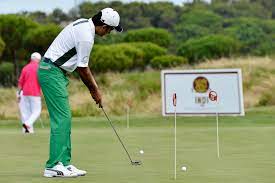
Golf is a game of precision, skill, and strategy. A strong golf swing is essential to your success on the course, but perfecting your swing can be a challenging task. Fortunately, there are a variety of golf swing drills you can incorporate into your practice routine to help improve your swing mechanics, consistency, power, and accuracy. In this article, we'll explore some of the key golf swing drills and techniques you can use to elevate your game to the next level.
The Importance of Golf Swing Drills
Before we dive into specific golf swing drills, it's important to understand why they're so critical to your success on the course. Practicing golf swing drills can help you:
- Develop a strong and repeatable golf swing
- Address common swing faults and bad habits
- Improve your swing mechanics, consistency, and accuracy
- Generate more power and distance on your shots
- Build confidence and mental toughness
- Lower your scores and enjoy the game more
Whether you're a beginner golfer or a seasoned pro, incorporating golf swing drills into your practice routine can help you achieve your goals and reach your full potential.
Key Fundamentals of the Golf Swing
Before you can start practicing golf swing drills, it's important to understand the key fundamentals of a good golf swing. These include:
- Grip: The way you hold the club can impact your swing path, clubface angle, and overall shot accuracy. Make sure you have a grip that's comfortable and consistent for you.
- Stance: Your stance affects your balance, weight distribution, and clubhead speed. Make sure you have a stance that's aligned with your target and provides a stable foundation for your swing.
- Posture: Good posture is critical for a consistent and powerful golf swing. Make sure you have a straight back, bent knees, and relaxed shoulders at address.
- Alignment: Proper alignment ensures that you're aiming at your target and reduces the likelihood of hitting errant shots. Make sure your feet, hips, and shoulders are aligned with your target line.
Common Swing Faults and How to Address Them
Even the best golfers have swing faults and bad habits that can affect their performance on the course. Here are some common swing faults and drills you can use to address them:
- Swing Plane: If you struggle with an inconsistent swing plane, try the "2x4" drill. Place a 2x4 board on the ground and make sure your club follows the same path as the board on your backswing and downswing.
- Tempo: If you have a quick or jerky tempo, try the "1-2-3" drill. Count "1" on your backswing, "2" at the top, and "3" on your downswing to develop a smoother and more consistent tempo.
- Release: If you struggle with an early release or casting motion, try the "club behind the back" drill. Hold a club behind your back with your arms crossed and practice swinging through the ball with your hips and lower body leading the way.
- Path: If you struggle with an outside-in or inside-out swing path, try the "towel under the arm" drill. Place a towel under your lead arm and practice making swings without letting the towel fall out to promote a more neutral swing path.
Golf Swing Drills for Consistency
Consistency is key to a successful golf game. Here are some golf swing drills you can use to improve your consistency:
- Swing Plane Drills: Use a training aid or alignment stick to ensure your club is following the proper swing plane. Practice making slow and deliberate swings to get a feel for the correct plane.
- Tempo Drills: Use a metronome or count out your swing to develop a consistent tempo. Practice making swings with a steady rhythm and pace.
- Release Drills: Practice making half swings or three-quarter swings with a focus on a proper release. This will help you maintain a consistent release throughout your full swing.
- Path Drills: Use alignment sticks or other training aids to ensure you're swinging on the correct path. Practice making swings with a neutral path to improve your ball's flight and consistency.
Golf Swing Drills for Power and Distance
If you're looking to add more power and distance to your golf game, here are some golf swing drills to try:
- Swing Speed Drills: Practice making swings with a focus on generating more clubhead speed. Use a lighter club or a speed training aid to help build up your swing speed.
- Rotation Drills: Practice making full swings with a focus on rotating your hips and shoulders through the ball. This will help you generate more power and distance.
- Impact Position Drills: Use a training aid or a mirror to practice getting into a proper impact position. This will help you maximize your energy transfer and generate more distance on your shots.
Golf Swing Drills for Short Game
A strong short game is essential to lower your scores and improve your overall golf game. Here are some golf swing drills to improve your chipping, pitching, and putting skills:
- Chipping Drills: Practice chipping with a variety of clubs and targets. Focus on getting the ball rolling on the green as soon as possible to help control your distance and accuracy.
- Pitching Drills: Use a training aid or a rope to practice hitting pitch shots with a consistent trajectory and spin. This will help you control your ball flight and improve your scoring around the green.
- Putting Drills: Practice putting with a focus on speed and line. Use a putting mat or a putting training aid to help improve your stroke mechanics and distance control.
Tips for Incorporating Golf Swing Drills into Your Practice Routine
To get the most out of your golf swing drills, here are some tips for incorporating them into your practice routine:
- Set Goals: Identify areas of your game that need improvement and set specific goals for your practice sessions.
- Create a Routine: Develop a structured practice routine that includes a variety of golf swing drills and short game drills.
- Use Technology: Use video analysis or a launch monitor to track your progress and identify areas for improvement.
- Stay Motivated: Keep a positive attitude and celebrate small victories along the way to stay motivated and engaged in your practice routine.
Conclusion
Practicing golf swing drills is essential to improve your golf game and reach your full potential on the course. By focusing on key fundamentals, addressing common swing faults, and incorporating a variety of golf swing drills into your practice routine, you can develop a strong and repeatable golf swing that will help you hit more accurate, powerful, and consistent shots. So, take the time to practice and incorporate these drills into your routine, and watch your golf game soar!
